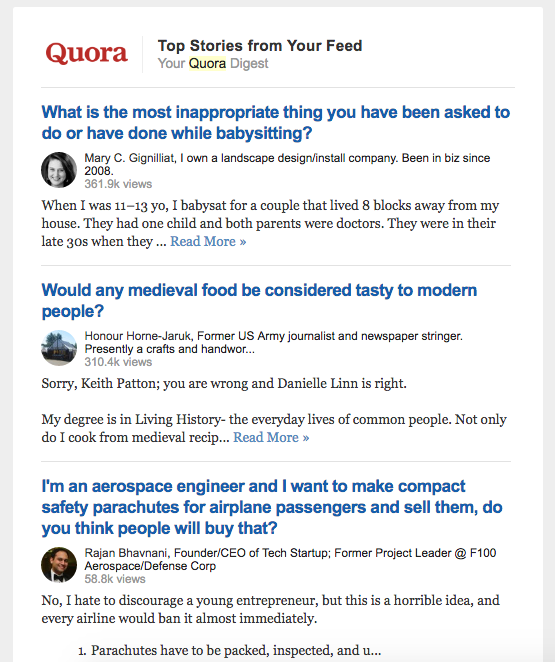Email Campaigns: 50 Strategies, Ideas & Examples
It’s no secret that email marketing is still the #1 most effective marketing channel around. Email has been shown to have a whopping 3800% ROI and $38 for every $1 spent. A staggering 44% of all email recipients last year made at least one purchased based on an email they received. Based on the results it’s hard to deny that email is the Lebron James (i.e., the king) of all marketing channels.
But Jordan, email is for dinosaurs. Instagram is so much more fun! I get to heart pretty photos and show people how cute our office dog is, why email?
Because email is permission based. This means folks are opting-in to give you permission to market to them. Your communication is warranted thus more effective.
Compared to social media or PPC, which does their best to shove ads in our faces, email has more finesse.
In this article you’ll explore 50 email campaign strategies, ideas, and examples to get the most out of your email campaigns.
***
1. Get permission
First and foremost get permission before emailing anything to anyone. Anti-SPAM regulations are becoming increasingly strict and you’re likely to pay a strict price for ignoring them.
Include a checkbox on your opt-in form and have readers agree to receive communication from you. Your future self will thank you.
2. Get whitelisted
To prevent your emails from being sent directly to a user’s trash or SPAM folder it might be wise to include a bit of text in your welcome email instructing them to whitelist your emails. Email service providers do their best to alleviate users of unnecessary or spammy emails. Kindly ask your subscribers to add your email address to their whitelist (i.e., your list of accepted emails) to avoid any missing any of your value-packed emails.

3. Manage expectations
Once a subscriber opts-in you’ll want to give them detailed information on what they should expect. Are you emailing them weekly? Monthly? What kind of content? What should they expect to hear from you? Manage their expectations to avoid confusion, frustration, and an overall healthy relationship.

4. Segment, segment, segment
A bit of personalization goes a long way when it comes to email marketing. Segmenting your subscribers into categories allows you to easily add relevant communication to each email. When visitors opt-in for example, they can enter in their industry. A real estate agent can then be sent lead generation tips while a yoga studio can be sent social media tips. Segmentation is a powerful tactic that increases relatability and conversions.

5. Offer at the right time
Sending emails at the appropriate time can have significant impact on your open rates. Of course testing this with your audience is paramount. Knowing who your subscribers are is half the work, know when their businesses hours are a start there.
6. Offer something in return
Give your visitors a reason to opt-in and give your subscribers a reason to open. Remember that we’re all incentive driven and an offer tailored just for us it hard to resist.
7. Test on a variety of platforms
Email has been around for a long time and the technology can be somewhat finicky. A testing platform will allow you to test your emails across browsers and email service providers. Your open and CTRs can be impacted by your emails simply not working properly.
There are several email testing tools out there like Litmus’ PutsMail. The only things worse than sending a crappy email is sending an email that doesn’t work at all.
8. Source exclusive offers
Having source exclusive offers for your email list subscribers is an effective way to enticing visitors to opt-in. Special promotions and discounts for example, can be a powerful incentive for ecommerce stores. Exclusive updates or content can go a long way to make subscribers feel valued.

9. Be casual not formal
Our email inboxes are a personal space and we don’t just let any unwanted emails inside. It’s our space to have personal, meaningful conversations so we tend to relegate soulless promotions and advertisements to a separate folder. In that case it helps to communicate in a casual way as opposed to formal. Have a real conversation with your subscribers and constantly try to engage them — it pays to have a personality.

10. Spend more time on the subject line
Many of us will place most of our attention on the content of the email and gloss over the subject line and wonder why our open rates are lower than the temperature of Taylor Swift’s heart.
In reality your subject lines should be taking up the majority of your time and attention. Most professional copywriters will write up to 10-20 subject lines, refine them, and pick the best one. You’d be wise to do the same.

11. Reward people for reading
Either in the subject line or through the basis of expectation your subscribers should know why they’re reading your emails. What are they getting for opening? Would they be missing out on something for deleting it?
It all comes down to providing the value your subscribers are looking for. Deliver each time and reward them for reading.
12. Use your actual name
Using your actual named as opposed to no-reply adds a bit more personality to your email. As I said before, our email inboxes are a personal space meant for one-on-one communication. The more personality your emails have the stronger a connection you’ll be able to build.
13. Be on their side
Familiarize yourself with your subscribers. Ultimately they subscribed to your email list for a reason, never forget that. Empathize with them and remind them that you understand their struggles.
14. Use a number
In subject lines and copy use numerals instead of written numbers. Large numbers (e.g. 50 instead of fifty) stand out amongst text and grab attention.
15. Custom Facebook opt-in tab
Don’t forget social media when it comes to building your email list. Facebook pages allow custom tabs to be created for any purpose. Create a custom tab of your own to send Facebook visitors to your email opt-in page. Be sure to include copy that details the benefits of becoming an email subscriber and what kind of content you’ll be mailing out.
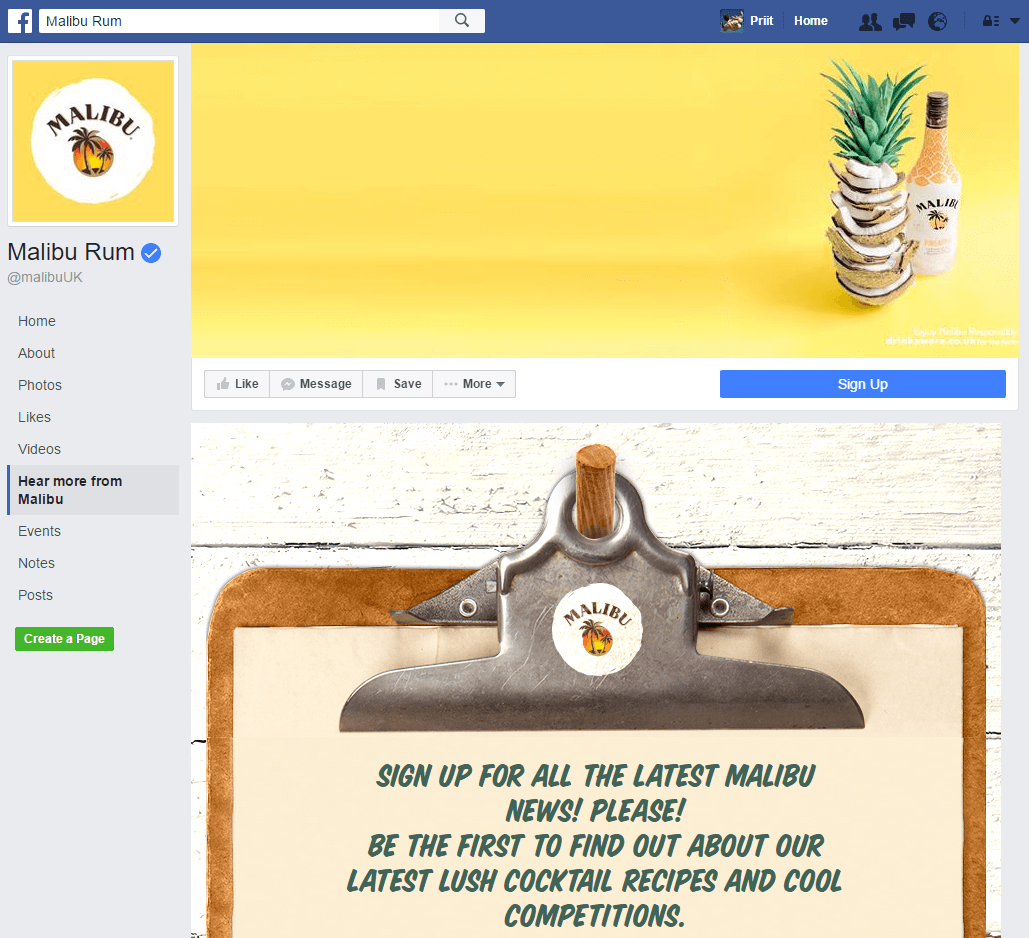
16. Regularly promote your list on social media
One of the problems with social media marketing is dealing with its low organic reach and poor conversion methods. Turn your social media followers into high-impact email subscribers by regularly promoting your email list on social media. Detail the benefits of becoming an email subscriber and it’ll be hard to resist the change.
Subject line tips
17. Quit being clever
The last thing a subject line should be is clever. A subject line rife with confusion or unambiguity is more likely to result in a delete than an open. Personally, if I don’t know what an email will contain within seconds I’ll delete it.
Make it clear what the email is about. Make it obvious they that need to see what’s inside. Quit being clever and start being specific, your open rates will thank you.
18. Use emotional words
Certain words have the power to create emotion inside of us all. Emotion creates action, action that opens an email to learn more. Take a look at this huge list of emotional words and use them liberally in your subject lines.
19. Create curiosity
The feeling of wanting to know more can be a powerful action trigger. Creating curiosity will tempt recipients to learn more. One way of creating curiosity is by limiting the information you provide. Hint at the information but don’t give it all away.
Will what’s inside change your life? Will it change your day? Who knows?! Open the email and find out.

20. Create urgency
There won’t be a better time to buy than right now. That’s urgency. Phrases like “last chance!” or “deal ends at midnight tonight!” are examples of ways you can communicate urgency. The fact is most people won’t take action unless they know a deal is about to slip right through their fingers. Create urgency to make your readers act NOW.
21. Use power words
As I said before, words have the power to create emotion. Emotion is the gateway to action. As NHL players need their hockey sticks to make plays, copywriters need power words to create action. Keep this list of power words handy when crafting your next subject line.
22. Make a promise
Promise that opening your email will be worth their time. Not by literally stating it but by implying that what’s inside is of great interest to your subscriber. Whether that be for some free resource or for a link to an value-packed article you’ve been working on for a while. Promise that if they take a look, they won’t regret it.
23. Don’t forget the preview text
Email service providers use a small area called the preview text to show a small snippet of an email’s contents. It’s highlighted in red in the example below.
Most email tools allow you to edit the preview text with more copy that entices the recipient to open. A discount percentage or a news snippet are all things that can add a little bit more temptation for the recipient.

24. Make sure it’s branded
If your email is being sent from your name or another person’s name without any company branding it could be ignored by the recipient.
When I subscribed to the Kissmetrics newsletter I received emails from Tomasz Borys. Having no idea who that was I promptly deleted it. It wasn’t until I accidentally opened one I knew it was from Kissmetrics.
Include some sort of branding in your email so that the recipients know who the emails are coming from.

25. Use the word ‘you’
This comes back to making your communication more personal. Using the word ‘you’ implies you’re speaking directly to your recipient. Our email inboxes are meant for one-to-one communication and speaking in a direct tone elicits a stronger reaction.
26. Point out common problems
Part of being on your audience’s side is identifying with their problems. Highlighting common problems and noting that you experience them as well is one step in the direction of familiarity.
You want to familiarize yourself with your subscribers. The better you can do so the more trust you will build. The more trust the relationship has the more trust your overall recommendations will have.
27. Stop following meaningless stats
Keep your subject line short. Actually make it as long as possible. Use emoticons liberally. Wait, don’t use emoticons, they’re unprofessional.
Stop following meaningless statistics. Every marketing website will give you varying statistics one way or the other. Always test what’s best for your exact audience.
28. Exclusivity — This is not for everyone, maybe not even you…
Exclusivity constantly ranks as a high incentive for action. Excluding or even the thought of exclusion is enough to made people question themselves and act out of emotion. The exclusive golf/country club on the west side or the exclusive mastermind business group, are all things that are longed after by outsiders. “You won’t let me into the VIP area?!… I’ll show you.”
Infuse a bit of exclusivity in your email subject lines for a little more punch. Make your offer exclusive or the act of claiming a rare deal or product.
Example: Conversion Rate Experts – Read this only if your sales exceed one million
29. The 9-word re-engagement email
One person got 750 responses after emailing 1,200 people on a stagnant list (a 62.5% response rate!)
Here’s how to do it:
Subject line: {first name}
Body: Are you still looking at getting [insert your service/product]?
Here are a few examples:
- “Are you still looking at getting your kitchen renovated?”
- “Are you still looking at building a new website?”
- “Are you still looking at buying a new car?”
- “Are you still looking at growing your blog traffic?”
Here is an example of how the whole email should look:
From: Website Business
To: bob@company.com
Subject: Bob
Body:
Are you still looking to redesign your website?
– Jordan
=========
That’s it! But why does this work so well?
This email generates curiosity and a certain level of personalization. The casual nature makes it seem like it’s coming from a real person thus will garner a real response. I’m referring to a previous interest of Bob’s and keeping it short and snappy.
30. Don’t overuse caps or exclamation points
As I mentioned before, email service providers don’t let much SPAM slip by their filters. One way they catch SPAM is by simply removing emails that overuse capitalization and exclamation points.
You’ve seen the type of emails, “MAGICAL WEIGHT LOSS, LOSE 80 POUNDS IN A WEEK.” Keep capitalization and exclamation points to a conservative amount or risk being sent straight into the abyss.
31. Benefit + curiosity
This subject line formula ranks as one of my favourite because it’s dead simple to remember. Benefit and curiosity, that’s it! What’s in it for them? And why should it interest them?
IWillTeachYou’s Ramit Sethi uses this technique liberally in his emails. He writes down one thing that his audience would love to learn and mixes it with something curious.

Email subject line examples
32. The Case Study Email
Formula: [Case Study] [Result of Case Study]
Example: [Case Study] Unlikely Story of a Small Time Designer Who Made Millions
33. The How To Email
Formula: How To [Achieve Desired Result]
Example: How To Double Your Email Open Rates
34. The School Of Email
Formula: [Insert Celebrity] School Of [Topic]
Example: Joanna Wiebe’s School of Copywriting
35. The Do This Email
Formula: Do THIS [Benefit]
Example: Do THIS if you want to triple opt-in rates
36. The Branded Newsletter Email
Formula: [Name of Newsletter] [Issue #]
Example: VSCO Issue #64
37. The New Post Email
Formula: [New Post] [Blog Post Headline]
Example: New Post: 24 iPhone Tricks
38. The Versus Email
Formula: [Subject] vs [Subject]
Example: MailChimp vs ConstantContact
39. The Authority Email
Formula: [Authority’s Name] [Topic + Secret/Tips]
Example: Mark Cuban’s Morning Ritual
40. The Flash Sale Email
Formula: [Flash Sale] [Name of Product] [Discount]
Example: Flash Sale: Nordstrom up to 45% off
41. The Avoid Email
Formula: Avoid These [Number] [Topic] [Pitfalls/Mistakes]
Example: Avoid these 10 copywriting mistakes
42. The What I Learned Email
Formula: What I Learned After [Accomplishment]
Example: What I learned after getting to the front page of Reddit
43. The Results Email
Formula: How We [Result] In [Timeframe]
Example: How we got 100k uniques on zero ad budget
44. The Three-Point Email
Formula: [Topic 1], [Topic 2], and [Main Topic]
Example: UFC, red eyes, and email open rates
6 of our favourite email campaigns
45. IFTTT
If you’re a fan of the simply smart automation app IFTTT then you’re probably a fan of their emails as well.
What we like about this email:
- Playful minimal design makes reading it a pleasure.
- New integration updates always provide value to IFTTT users.
- Brevity. IFTTT never fills emails with too much copy.
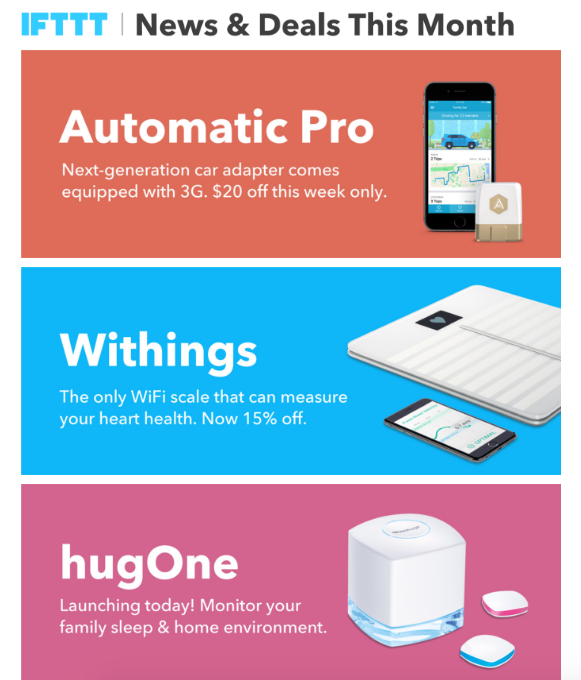
46. Inbound
If you’re part of the Inbound community then you’re likely receiving their engagement emails.
What we like about this email:
- It’s meant to engage their community members in various ways. This one in particular is for voicing your opinion through a survey question.
- It includes personalized content tailored to my interests.
- Contrasted so that each CTA is clear and distinct.
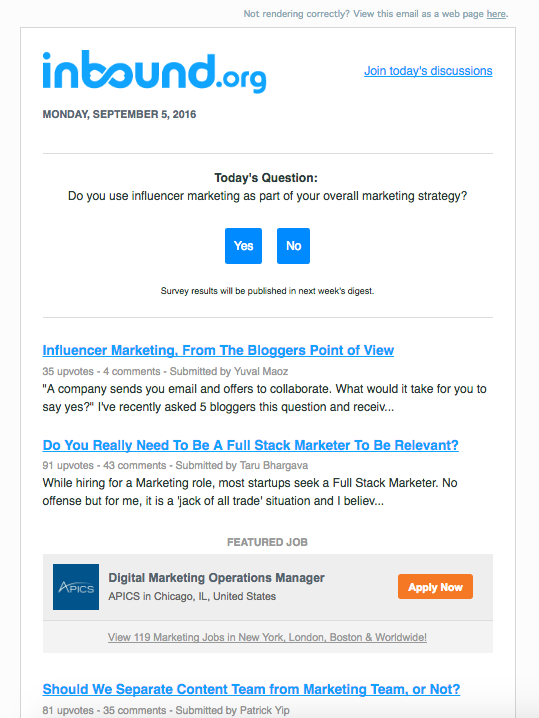
47. SquareSpace
Website development tool SquareSpace is no slouch when it comes to its email campaigns. Each email sent is calculated to create a specific action and response.
What we like about this email:
- SquareSpace understands. “Need more time?” they ask. They understand we can all get busy and offer to extend the free trial period for users. They’re on our side and take steps to show it.
- SquareSpace keeps it simple. You can choose to extend or upgrade. Nothing else distracts.
- They’re there to help. They end the email in the best way possible, asking to know how they can help you succeed.
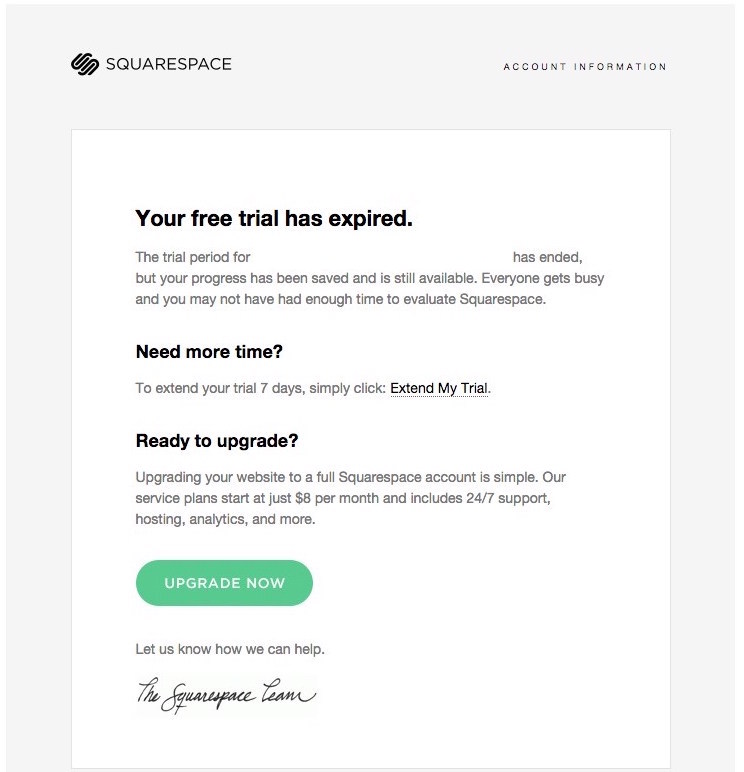
48. Groove
We’re big fans of Groove’s emails here at Wishpond. They always prove to be packed with useful info and helpful content.
What we like about this email:
- It’s casual. Like much of what Groove does, things are kept casual and conversational. It’s like receiving an email from an old friend.
- Not overly promotional. The few CTA present are done with inline links and no big bright buttons. It’s all a part of their casual tone of voice.
- Sent from the CEO. Receiving an email from the CEO Alex only adds more value to the email. He even includes a handy pre-populated tweet for easy sharing.

49. DeathtoStock
Free stock photo resource DeathtoStock packs in the value with every single email they send. It’s one of the few email subscription I’d never opt-out from.
What we like about this email:
- Imagery. Being a photo website, DeathtoStock includes a beautiful example photo to entice recipients to click through.
- Value packed. Who doesn’t love free stuff. DeathtoStock includes 5 free awesome stock photos every month to their subscribers.
- Simple. Not overcrowded with text, the desired action of the email is clear.
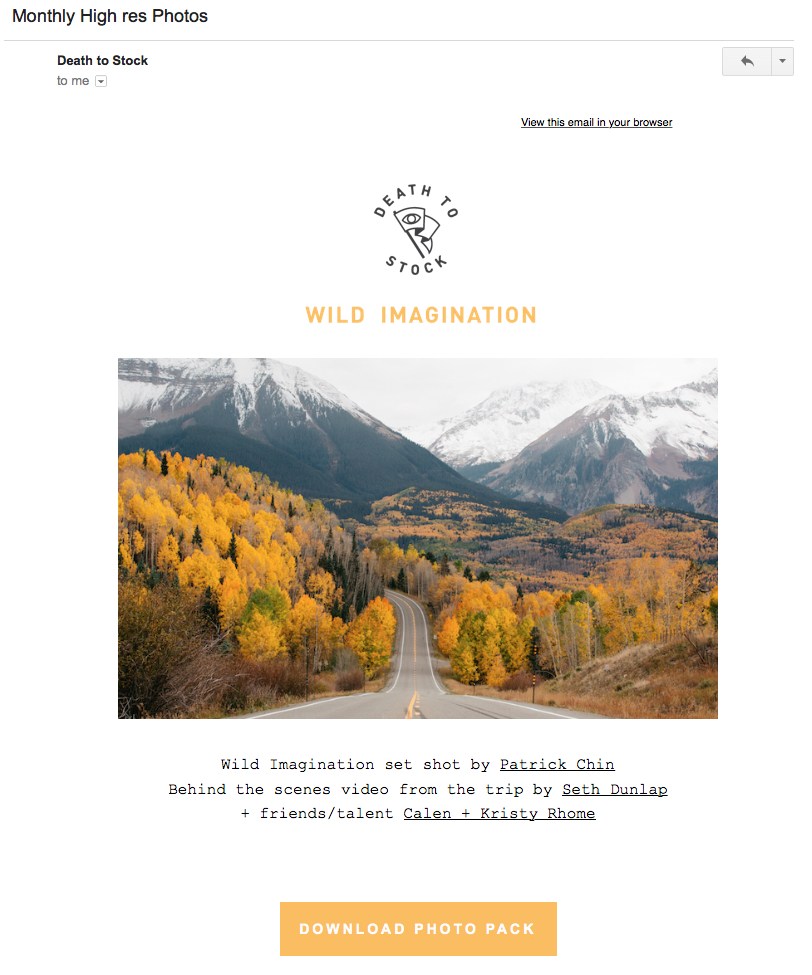
50. Quora
Everyone’s favourite question and answer website is the perfect example of personalization. Weekly, Quora sends you questions tailored to your expertise and interests.
What we like about this email:
- Personalized. The content of the email is based on your interests and areas of expertise so that it is always relevant.
- Just enough content to peak the curiosity of the reader. After reading a few sentences it’s hard to resist clicking through to read more.
- Simplicity. The copy is the focus of Quora emails so it is seldom weighed down by too much imagery.
